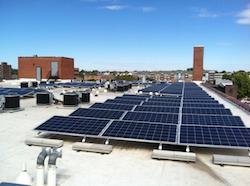I love the concept of re-use in terms of living spaces. I live in a former tea manufacturing facility dating back to the mid-1800s and integrating original features of the building give my loft a unique and cool character. While this is an ongoing trend, not many of the refurb buildings in the Midwest are featuring renewable energy. (I wish mine did.) But this one has it all – the Laclede Lofts based in St. Louis, Missouri.
The adaptive-resue project has a cool aura and uses various green features including high-efficiency appliances and light fixtures, but it also features a 250 kilowatt solar array on the roof that generates more than half of the electricity used in the building’s common areas. This project is a joint venture between Universatile Development and Rothschild Development redeveloped the former pharmaceutical factory, located near St. Louis University.
 Jeff Winzerling, president of Universatile Development, said, “We estimated, for the course of a year, the total electrical usage for everything in the common areas: parking lot lights, lobby and hallway air-conditioning, elevator, gate opener, and security system. Even by the more conservative production projection, the array is producing 62% of our usage needs.”
Jeff Winzerling, president of Universatile Development, said, “We estimated, for the course of a year, the total electrical usage for everything in the common areas: parking lot lights, lobby and hallway air-conditioning, elevator, gate opener, and security system. Even by the more conservative production projection, the array is producing 62% of our usage needs.”
Microgrid Solar engineers worked with the developer to explore a few different options for deploying solar power at the art deco building, which the Pfeiffer Pharmaceutical Company constructed in 1946 to house its offices, laboratories, manufacturing, and warehouse. In the end, the developer settled upon the simplest solution: a single 25kW array consisting of 98 solar panels with microinverters connected to the building’s common area meter. Winzerling added, “It would have been really cool to have some solar-powered apartments, but the complexity and expense would have been much greater, so we opted for a solar-powered building instead.”
Microgrid CEO, Rick Hunter, added, “This is a unique project, utilizing solar on a historic renovation project and an apartment building – you just don’t see this sort of thing very often, due to the challenges involved. We are thrilled to have been a part of the project.”
Another cool feature – a link was added to the building’s website that allows building residents and others to monitor the panels’ production over time, as well as to see the electrical output converted into reduced carbon dioxide emissions, either in trees planted or miles not driven.

